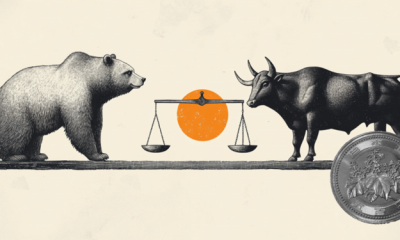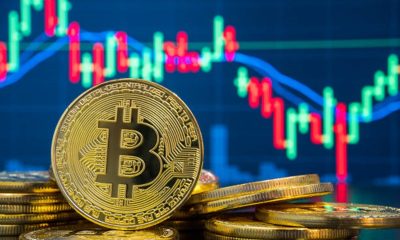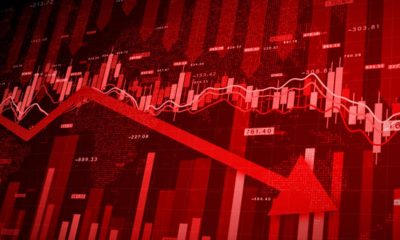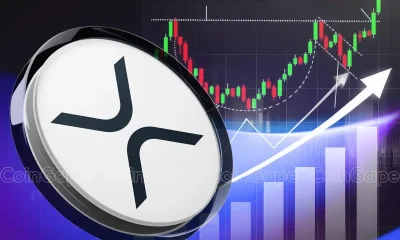

others
US Dollar recovers modestly as markets assess latest headlines on Trump tariff policy – Crypto News
Here is what you need to know on Wednesday, February 26:
The US Dollar (USD) holds its ground against its rivals early Wednesday as markets adopt a cautious stance. The US economic calendar will feature New Home Sales data for January. Later in the American session, Atlanta Federal Reserve President Raphael Bostic and Richmond Federal Reserve President Thomas Barkin will be delivering speeches.
US Dollar PRICE This week
The table below shows the percentage change of US Dollar (USD) against listed major currencies this week. US Dollar was the weakest against the Swiss Franc.
| USD | EUR | GBP | JPY | CAD | AUD | NZD | CHF | |
|---|---|---|---|---|---|---|---|---|
| USD | -0.32% | -0.15% | 0.22% | 0.71% | 0.43% | 0.52% | -0.41% | |
| EUR | 0.32% | 0.08% | 0.38% | 0.85% | 0.74% | 0.65% | -0.26% | |
| GBP | 0.15% | -0.08% | 0.32% | 0.76% | 0.68% | 0.57% | -0.34% | |
| JPY | -0.22% | -0.38% | -0.32% | 0.49% | 0.29% | 0.38% | -0.53% | |
| CAD | -0.71% | -0.85% | -0.76% | -0.49% | -0.33% | -0.19% | -1.09% | |
| AUD | -0.43% | -0.74% | -0.68% | -0.29% | 0.33% | -0.09% | -0.99% | |
| NZD | -0.52% | -0.65% | -0.57% | -0.38% | 0.19% | 0.09% | -0.90% | |
| CHF | 0.41% | 0.26% | 0.34% | 0.53% | 1.09% | 0.99% | 0.90% |
The heat map shows percentage changes of major currencies against each other. The base currency is picked from the left column, while the quote currency is picked from the top row. For example, if you pick the US Dollar from the left column and move along the horizontal line to the Japanese Yen, the percentage change displayed in the box will represent USD (base)/JPY (quote).
Falling US Treasury bond yields after US Treasury Secretary Scott Bessen said that the Trump administration will find a way to reduce spending and ease monetary policy at the same time weighed on the USD on Tuesday. As the benchmark 10-year US T-bond yield fell more than 2% on the day, the USD Index lost about 0.4%. Early Wednesday, the 10-year yield stays in positive territory above 4.3% and the USD Index clings to recovery gains at around 106.50.
Meanwhile, US President Donald Trump’s trade adviser, Peter Navarro, said that tariff negotiations are ongoing with Canada and Mexico and noted that they will set a reciprocal tariff for digital services tax. Additionally, Trump signed an executive order late Tuesday to launch an official probe into copper markets, specifically an investigation into pricing of futures and delivery markets, citing national security concerns.
EUR/USD rose more than 0.4% on Tuesday but lost its bullish momentum early Wednesday. At the time of press, the pair was trading marginally lower on the day, a few pips below 1.0500. Earlier in the day, the data from Germany showed that the GfK Consumer Confidence Index for March dropped to -24.7 from -22.6.
Following Monday’s decline, GBP/USD registered small gains on Tuesday. In the European morning on Wednesday, the pair fluctuates in a tight channel at around 1.2650.
AUD/USD failed to benefit from the selling pressure surrounding the USD and closed in negative territory for the third consecutive trading day on Tuesday. The pair stays on the back foot early Wednesday and trades below 0.6350. In the Asian session, the data from Australia showed that the annual Consumer Price Index (CPI) rose 2.5% in January, matching December’s increase.
USD/JPY lost nearly 0.5% on Tuesday and registered its lowest daily close since early October. The pair stages a rebound in the European morning on Wednesday and trades near 149.50.
Gold came under heavy selling pressure on Tuesday and lost more than 1% on the day. After touching its lowest level in over a week at $2,888, however, XAU/USD managed to erase a portion of its daily losses to close above $2,900. As of writing, the pair was moving up and down in a tight channel slightly above $2,910.
Risk sentiment FAQs
In the world of financial jargon the two widely used terms “risk-on” and “risk off” refer to the level of risk that investors are willing to stomach during the period referenced. In a “risk-on” market, investors are optimistic about the future and more willing to buy risky assets. In a “risk-off” market investors start to ‘play it safe’ because they are worried about the future, and therefore buy less risky assets that are more certain of bringing a return, even if it is relatively modest.
Typically, during periods of “risk-on”, stock markets will rise, most commodities – except Gold – will also gain in value, since they benefit from a positive growth outlook. The currencies of nations that are heavy commodity exporters strengthen because of increased demand, and Cryptocurrencies rise. In a “risk-off” market, Bonds go up – especially major government Bonds – Gold shines, and safe-haven currencies such as the Japanese Yen, Swiss Franc and US Dollar all benefit.
The Australian Dollar (AUD), the Canadian Dollar (CAD), the New Zealand Dollar (NZD) and minor FX like the Ruble (RUB) and the South African Rand (ZAR), all tend to rise in markets that are “risk-on”. This is because the economies of these currencies are heavily reliant on commodity exports for growth, and commodities tend to rise in price during risk-on periods. This is because investors foresee greater demand for raw materials in the future due to heightened economic activity.
The major currencies that tend to rise during periods of “risk-off” are the US Dollar (USD), the Japanese Yen (JPY) and the Swiss Franc (CHF). The US Dollar, because it is the world’s reserve currency, and because in times of crisis investors buy US government debt, which is seen as safe because the largest economy in the world is unlikely to default. The Yen, from increased demand for Japanese government bonds, because a high proportion are held by domestic investors who are unlikely to dump them – even in a crisis. The Swiss Franc, because strict Swiss banking laws offer investors enhanced capital protection.
-

 Cryptocurrency6 days ago
Cryptocurrency6 days agoSUI eyes 24% rally as bullish price action gains strength – Crypto News
-

 Cryptocurrency5 days ago
Cryptocurrency5 days agoCoinbase scores major win as SEC set to drop lawsuit – Crypto News
-

 Blockchain1 week ago
Blockchain1 week agoXRP Price Pulls Back From Highs—Are Bulls Still in Control? – Crypto News
-

 others1 week ago
others1 week agoJapanese Yen remains depressed amid modest USD strength; downside seems limited – Crypto News
-

 Blockchain1 week ago
Blockchain1 week agoWill BTC Rebound Or Drop To $76,000? – Crypto News
-

 Business1 week ago
Business1 week agoElon Musk’s DOGE Launches Probe into US SEC, Ripple Lawsuit To End? – Crypto News
-

 others1 week ago
others1 week agoForex Today: What if the RBA…? – Crypto News
-

 Technology1 week ago
Technology1 week agoLuminious inverters for your home to never see darkness again – Crypto News
-

 Business1 week ago
Business1 week agoWhales Move From Shiba Inu to FXGuys – Here’s Why – Crypto News
-

 Technology6 days ago
Technology6 days agoStellantis Debuts System to Handle ‘Routine Driving Tasks’ – Crypto News
-

 Business1 week ago
Business1 week agoWhat Will be KAITO Price At Launch? – Crypto News
-

 Blockchain1 week ago
Blockchain1 week agoXRP Set To Outshine Gold? Analyst Predicts 1,000% Surge – Crypto News
-

 Cryptocurrency1 week ago
Cryptocurrency1 week agoHayden Davis crypto scandal deepens as LIBRA memecoin faces fraud allegations – Crypto News
-

 Blockchain1 week ago
Blockchain1 week agoNEAR Breaks Below Parallel Channel: Key Levels To Watch – Crypto News
-

 Blockchain1 week ago
Blockchain1 week agoXRP Price Settles After Gains—Is a Fresh Upside Move Coming? – Crypto News
-

 others1 week ago
others1 week agoWTI price bullish, according to FXStreet data – Crypto News
-

 Metaverse1 week ago
Metaverse1 week agoHow AI will divide the best from the rest – Crypto News
-

 others1 week ago
others1 week agoGas prices still remain elevated – ING – Crypto News
-

 Business1 week ago
Business1 week agoThese 3 Altcoins Will Help You Capitalize on Stellar’s Recent DIp – Crypto News
-

 Business1 week ago
Business1 week agoWhy Ethereum (ETH) Price Revival Could Start Soon After Solana Mess? – Crypto News
-

 Technology5 days ago
Technology5 days agoWhy is BTC Down Today? – Crypto News
-

 Technology5 days ago
Technology5 days agoWhy is BTC Down Today? – Crypto News
-

 Technology5 days ago
Technology5 days agoWhy is BTC Down Today? – Crypto News
-

 Cryptocurrency5 hours ago
Cryptocurrency5 hours agoBinance CEO: we’re seeing a “tactical retreat” with crypto “not a reversal” – Crypto News
-

 Blockchain1 week ago
Blockchain1 week agoXRP Bullish Pennant Targets $15-$17 But Confirmation Is Required – Crypto News
-

 Technology1 week ago
Technology1 week agoUnion Minister Ashwini Vaishnaw to launch India AI Mission portal soon, 10 companies set to provide 14,000 GPUs – Crypto News
-

 Business1 week ago
Business1 week agoMarket Veteran Predicts XRP Price If Ripple Completes Cup and Handle Pattern – Crypto News
-

 others1 week ago
others1 week agoUS Dollar struggles to gather traction on quiet Monday – Crypto News
-

 Business1 week ago
Business1 week agoMEXC COO Tracy Jin on How AI Agents are transforming Web3 – Crypto News
-

 Cryptocurrency1 week ago
Cryptocurrency1 week agoRipple Whale Bags 20M Coins Amid Recent Dip, What’s Happening? – Crypto News
-

 Technology1 week ago
Technology1 week agoSouth Korea removes DeepSeek from app stores, existing users advised to ‘service with caution’ – Crypto News
-

 Blockchain1 week ago
Blockchain1 week agoBitcoin Price Falls Short Again—Is a Deeper Decline Coming? – Crypto News
-

 Business1 week ago
Business1 week agoNew Bitcoin Spiral Clock Model Predicts When Price Will End Bull Cycle – Crypto News
-

 Cryptocurrency1 week ago
Cryptocurrency1 week agoBitcoin Sees $430M in Outflows as Market Responds to Fed’s Hawkish Stance – Crypto News
-

 Cryptocurrency1 week ago
Cryptocurrency1 week agoJudge Assigned to Probe Argentina’s President Milei Over Alleged Crypto Scam – Crypto News
-

 Blockchain1 week ago
Blockchain1 week agoSolana Risks Further Drop – Is The SOL ‘Memecoin Fiesta’ Over? – Crypto News
-

 Technology1 week ago
Technology1 week agoHYPE Price Shoots 10% As Hyperliquid EVM Goes Live – Crypto News
-

 others1 week ago
others1 week agoRallying on unchanged rate projections – ING – Crypto News
-

 Cryptocurrency7 days ago
Cryptocurrency7 days agoBitcoin company joins the publicly traded ‘Fold’ – Crypto News
-

 Blockchain7 days ago
Blockchain7 days agoThe Secret Window You Need To Know – Crypto News
-

 Technology6 days ago
Technology6 days agoApple Watch Series 10 gets a discount of over ₹5,000 on Amazon: How to get it for ₹41,705 – Crypto News
-

 Cryptocurrency5 days ago
Cryptocurrency5 days agoCanary’s Litecoin ETF listed on DTCC – Will trading begin soon? – Crypto News
-

 others1 day ago
others1 day agoElliptic Says Lazarus Group Using eXch To Launder Stolen Funds Despite Requests From Bybit To Block Transactions – Crypto News
-

 Technology1 week ago
Technology1 week agoOnePlus 13 Mini tipped to retain OnePlus 13’s 6,000 mAh battery, launch timeline surfaces – Crypto News
-

 Blockchain1 week ago
Blockchain1 week agoEthereum Price Faces Renewed Pressure—Is a Breakdown Imminent? – Crypto News
-

 Technology1 week ago
Technology1 week agoBest portable bass Bluetooth speakers for ultimate music experience – Crypto News
-

 Blockchain1 week ago
Blockchain1 week agoCardano (ADA) Bulls in Action—Is a New Upside Run Beginning? – Crypto News
-
others1 week ago
Turkey Budget Balance increased to -139.26B in January from previous -829.2B – Crypto News
-

 Business1 week ago
Business1 week agoCardano Price Could Hit $7 Amid Growing Adoption – Crypto News
-

 Business1 week ago
Business1 week agoCardano Price Could Hit $7 Amid Growing Adoption – Crypto News


















